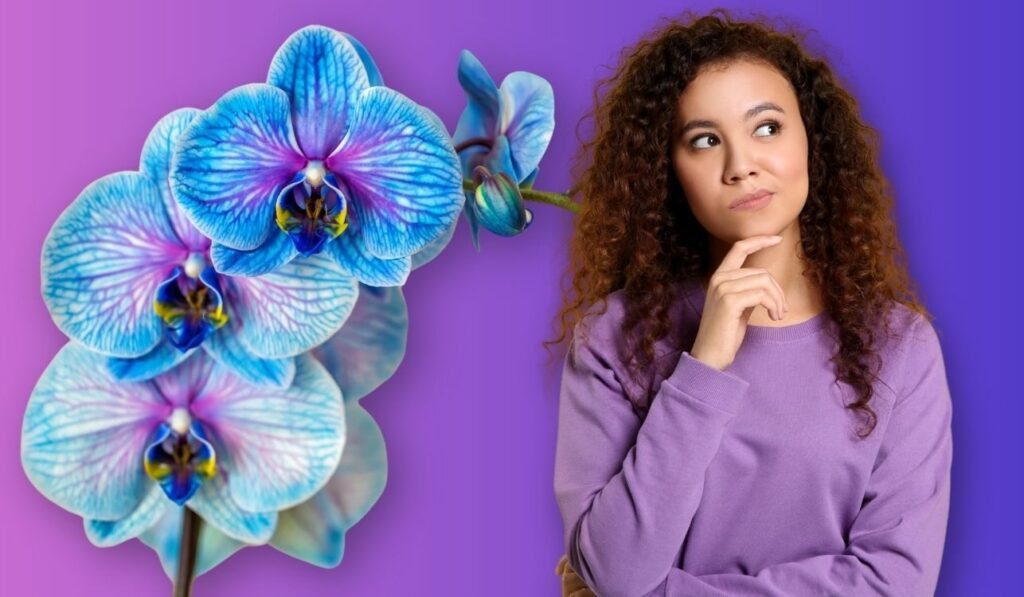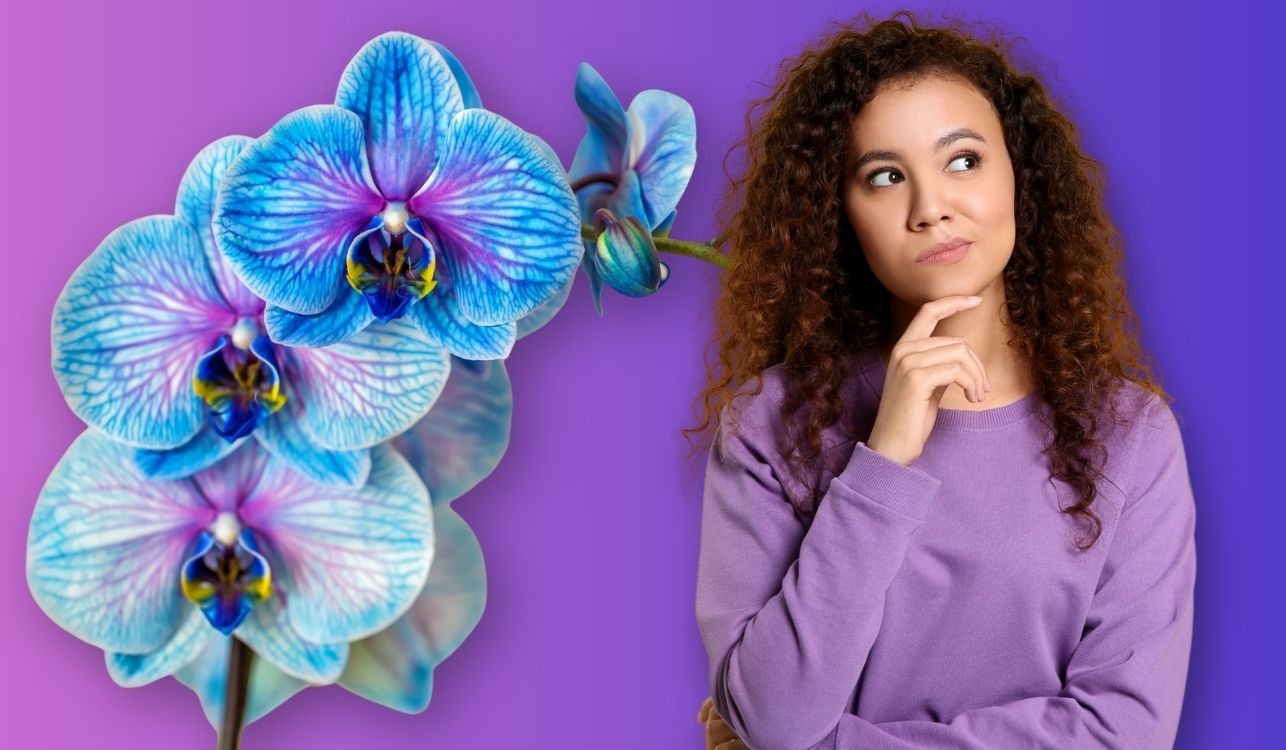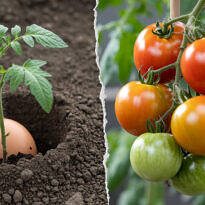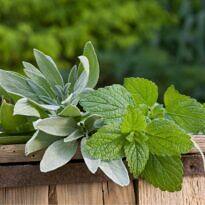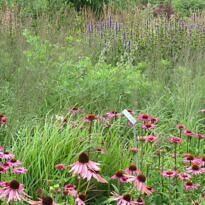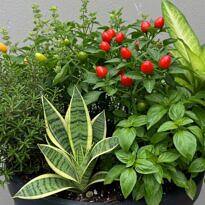Confused about the types of orchids?
I understand…
At the beginning of my life as a gardener, I bought many orchid seedlings, of various types, shapes, and species, and I barely knew how to take care of them.
Of course! I didn’t know them, and I didn’t even understand how to care for them (which can be quite different for each one!). But I was simply enchanted by the wonderful and exotic world of orchids, and I really wanted to see them grow and bloom under my care, just like you are doing now.
So, congratulations on reading this article. It shows that you are interested in advancing your knowledge of orchid cultivation, and I have great news for you:
In this article, you will get to know the main types of orchids and the different ways we can categorize them, so you will never get lost again. You will discover:
How many orchid species exist and how to differentiate them from other plants
It’s mind-blowing! But these beautiful flowers, known as orchids, belong to a plant family with around 28,000 species, distributed across 763 genera. In Brazil alone, there are approximately 2,590 species.
That’s right.
The Orchidaceae family, the orchid family, is one of the two largest families of flowering plants, along with the Asteraceae (the daisy and chrysanthemum family).
And as if that weren’t astonishing enough, there are still countless hybrids (natural and artificial crosses), as well as cultivars and varieties. So, the numbers I mentioned earlier only refer to natural species, those found in nature without human intervention in their crossbreeding.
Furthermore, orchids are found on almost every continent, except Antarctica, and can grow in a variety of environments, from tropical forests to arid regions.
Can you imagine?
The possibilities for developing new cultivars are enormous and infinite! That’s why new and beautiful orchids will always appear on the market to amaze us.
But how can you tell if what you have at home is really an orchid?
Many people ask me if this or that plant is an orchid. It’s amazing how plants can deceive us. A more elaborate and exotic flower appears, and we immediately think it might be a rare orchid.
But that’s not always true.
Outside the orchid family, there are many beautiful flowers with complex structures, long stalks, and modified petals that closely resemble orchid flowers.
Some species that often deceive us include iris and bat flowers. Moreover, other species have flowers very similar to orchids, such as the butterfly orchid, for example. But one thing is certain: these species are definitely not orchids!
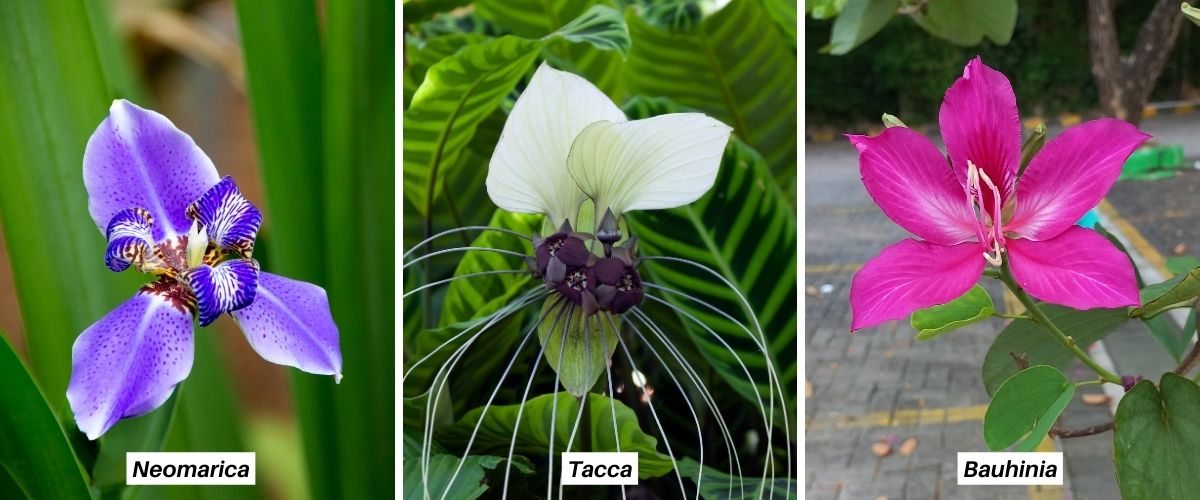
For a species to be classified as an orchid, it needs to have some characteristics that only plants in the Orchidaceae family possess.
Let’s learn how to identify them?
Since orchids have been around for a long time, some of them have changed a lot over time, while others have remained relatively unchanged. In other words, some have evolved more than others. Additionally, while some parts of a plant may have evolved significantly, other parts have remained the same for a long time. This varies greatly from one species to another.
It may sound confusing, and it is. But the point I want to make is that despite the guidelines below that help define orchids, there are many exceptions. So, while most species have these characteristics, there may be one or two that do not.
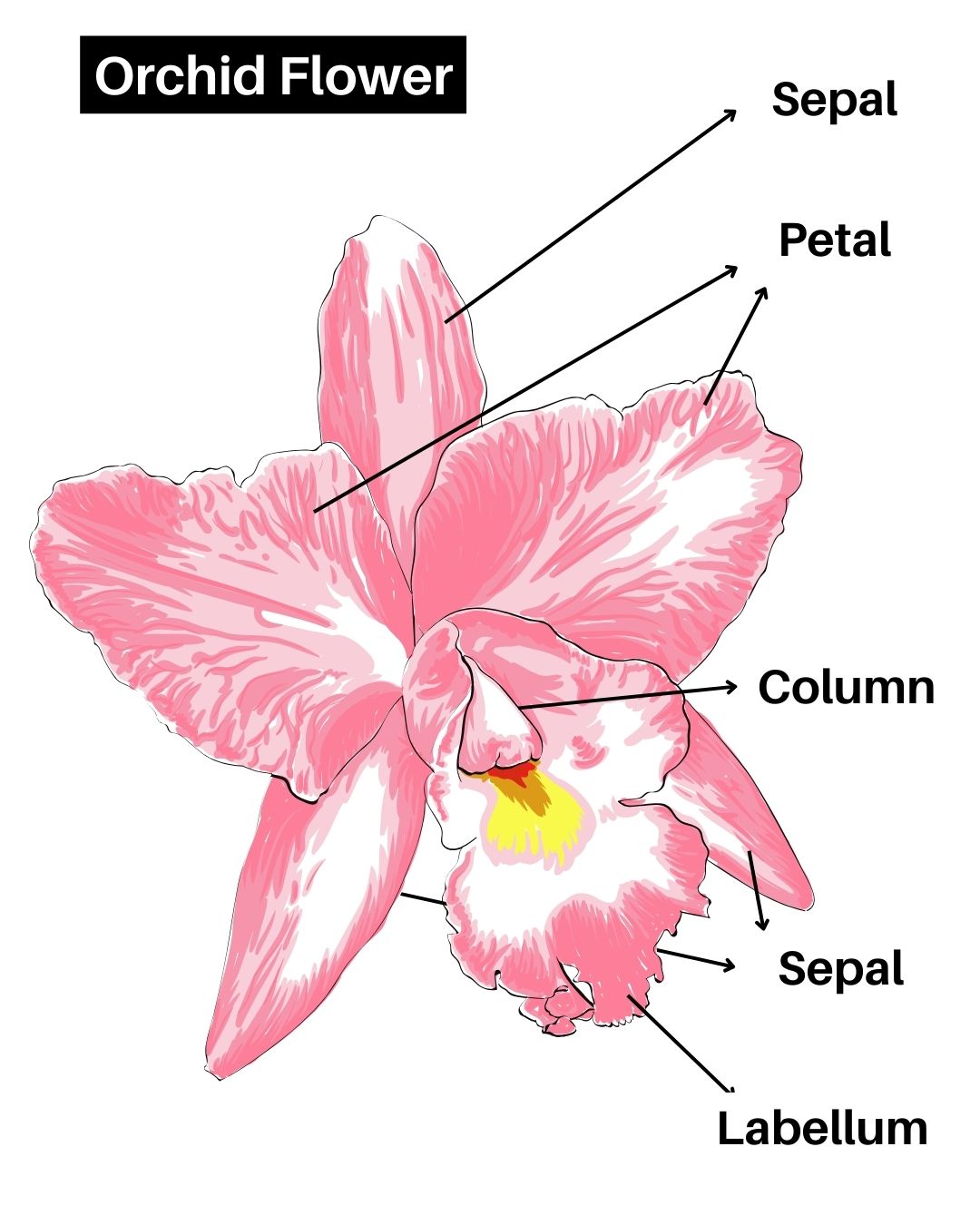
Here are some characteristics that differentiate orchids from other plant species:
- They have a special part called the “column” that is made up of both male and female parts of the flower.
- Their pollen forms cartilaginous structures called “pollinia.” These organs look like testicles, which is why they are named “orchid,” originating from the Greek word meaning “resembling a testicle.”
- Their seeds are very small and have few nutrients. They can only grow with the help of specific fungi.
- Their flowers have a different shape; they are not symmetrical like a circle but have six parts, three on the outside called “sepals” and three on the inside called “petals.” One of the petals is quite different from the others and is called the “lip.” This part is important for attracting pollinating insects to the flower. The lip is like a well-marked landing strip for bees, butterflies, and other pollinators to easily find where they need to land.
- Orchid flowers can appear upside down because their ovary rotates 180 degrees as it grows, a process called “resupination.” An exception to this rule is the genus Epidendrum.
- Many orchids that grow on trees have roots covered by a kind of sponge called “velamen.” Velamen is crucial! It allows orchids to store water for “later” and serves as a refuge for fungi that help the plant obtainnutrients.
Phew! Now it’s much easier to get to know orchids and differentiate them from other plant types.
How orchids are classified based on their growth type
We already know that orchids are majestic and fascinating flowers that captivate gardening enthusiasts around the world. But did you know that these beautiful plants can be classified based on their growth type?
That’s right; they can be divided into two main growth categories: monopodial and sympodial.

Monopodial Orchid Type
Monopodial orchids are like plants with a main stem that grows upward like a tower. Along this stem, especially at the top, they have leaves. Their flowers emerge between these leaves. Sometimes, monopodial orchids can branch out, but it doesn’t happen very often.
This type of orchid cannot hold much water, so they need to be watered frequently, without letting the substrate become too dry. It’s quite common for them to have roots that grow outside the pot, absorbing moisture from the air if the environment is humid enough.
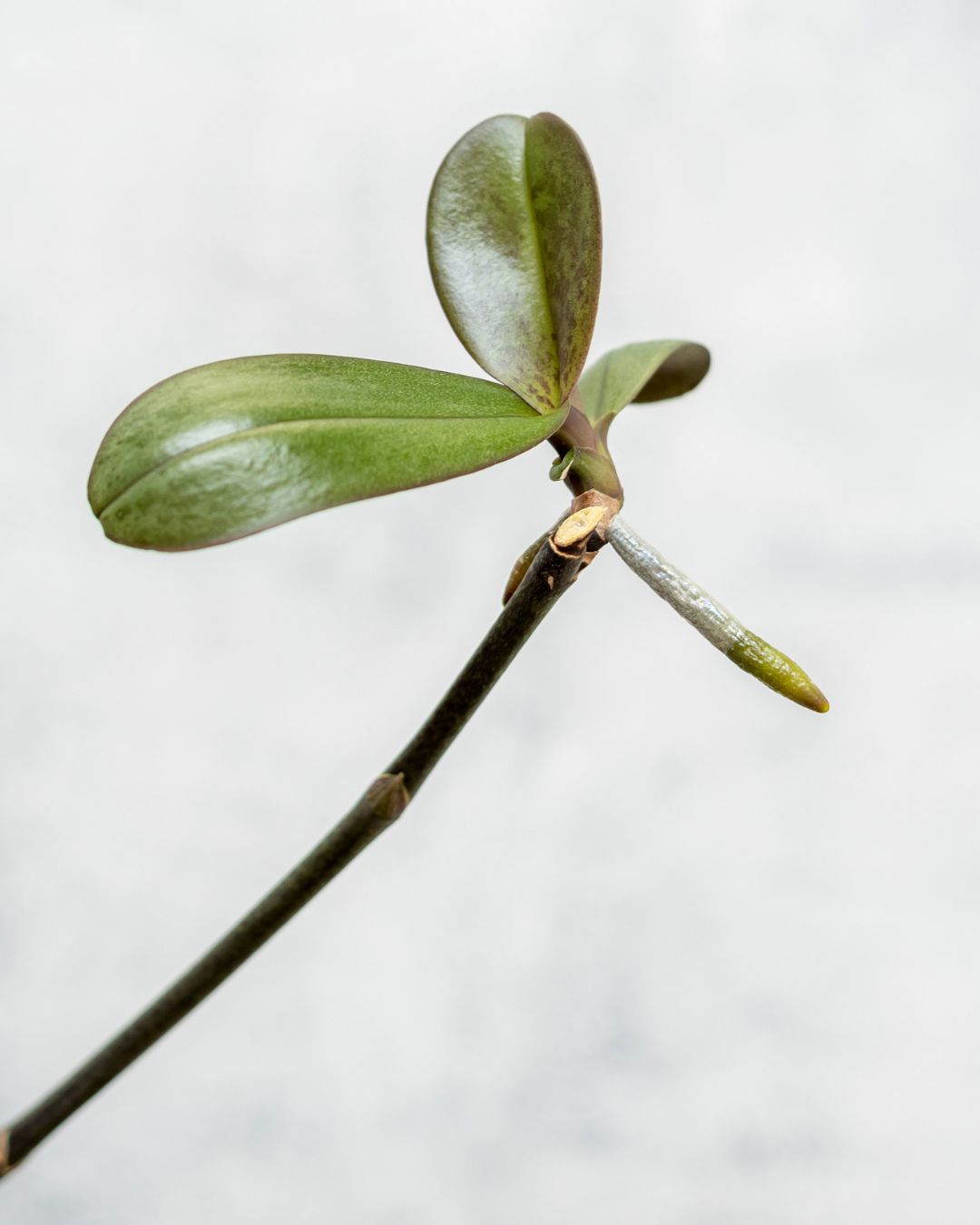
Dividing these orchids is difficult, so people usually don’t attempt it unless they are experts. If you want to propagate more of these orchids, the best way is to use small shoots called “keikis.” Keikis are tiny shoots that naturally emerge along the stem and flower spikes of this type of orchid. They can be quite common in some species but quite rare in others.
One good thing about these orchids is that you can use the same pot for a long time, changing the substrate after a considerable period. Some examples of monopodial orchids are Phalaenopsis orchids, Vandas, and Vanilla orchids.
Sympodial Orchid Type
Sympodial orchids are different. Their stem is a rhizome, from which new shoots usually emerge, typically one or two per year. This stem grows parallel to the substrate, meaning it can be underground, but it usually grows above the substrate. Each new shoot arising from the rhizome typically has one or two leaves, with a chubby part just below them called a pseudobulb. These pseudobulbs store water and nutrients for the plant’s future and can last for many years.
The flowers of sympodial orchids typically emerge from the base of the leaves, right at the junction between the leaves and the pseudobulb. After a flower blooms, the orchid may rest, then start growing a new part of the rhizome, and the cycle repeats. Usually, a pseudobulb that has already flowered will not flower again. Over time, it loses its leaves and eventually wilts and turns yellow, which is perfectly normal.
Propagating these orchids is much easier than monopodial ones. You can cut the rhizome into pieces, each having 3 or 4 pseudobulbs, along with a new shoot that is beginning to grow. Sometimes, older pseudobulbs can grow new shoots.
Some examples of sympodial orchids are Cattleyas, Laelias, and Oncidiums.
Types of Orchids Based on Substrate
Some dedicated orchid collectors prefer to subdivide orchids based on the type of substrate they grow in. After all, not every plant likes soil, and orchids are a prime example of that.
Many people might think that orchids are parasitic plants, but that’s a serious misconception. The vast majority of commercial orchid species are epiphytic, meaning they grow on the trunks of trees, without directly sapping nutrients from their host. They just need a support to live high up, providing shade and some humidity.
However, some orchids prefer different places to grow their roots, as we will see below:
- Saxicolous (rupicolous, or lithophytic): These orchids grow on rocks, usually in rock crevices or rocky terrain. For these orchids, it’s worth creating a substrate with crushed stone, charcoal, broken bricks, and even pebbles with different granulometries. Example: Laelia lucasiana
- Humicolous: These are orchids that grow in the soil, usually in forested areas where leaf litter and organic matter are abundant. These orchids can grow in the soil, as long as there is decomposing leaves and branches with plenty of humus. Example: Chloraea alpina
- Epiphytic: Epiphytic orchids grow on other plants, typically trees, using them as support, but they do not directly extract nutrients from them. They prefer lightweight substrates, such as pine bark, pieces of wood, sphagnum moss, or tree fern fiber. Good ventilation around the roots is important for these orchids. Example: Phalaenopsis.
- Terrestrial: These orchids grow in the ground, like most plants, and obtain their nutrients from it. However, it’s a good idea to make the substrate lighter by adding sand and organic matter for these orchids to thrive. Example: Bamboo orchid
- Aerophytes: Aerophytic orchids often grow perched on trees and rocks in highly humid environments, absorbing water and nutrients from the air. They require all irrigation and fertilization to be done through spraying on the roots and leaves. They do not need the substrate to be changed since there is no substrate, just a small basket for hanging them. Example: Vanda-teres
- Climbing: Some orchids are climbers, and despite having their roots in the soil or leaf litter, they grow by attaching themselves to structures like fences, trellises, or other plants. Example: Vanilla orchid
- Aquatic: These orchids grow in aquatic environments, on the edges of swamps or ponds, with their roots submerged in water. Example: Habenaria repens
- Halophytes: Halophytic orchids grow in saline environments, such as mangroves or coastal dunes, where the water has a high salt concentration. Examples: Beach Cymbidium, Epidendrum.
- Saprophytes: These orchids are peculiar because they do not perform photosynthesis and obtain nutrients from decomposing organic matter, such as decaying leaves in the forest floor. They are often white, pink, or yellow, lacking the characteristic green pigment (chlorophyll) that most plants have. Example: Rhizanthella gardneri
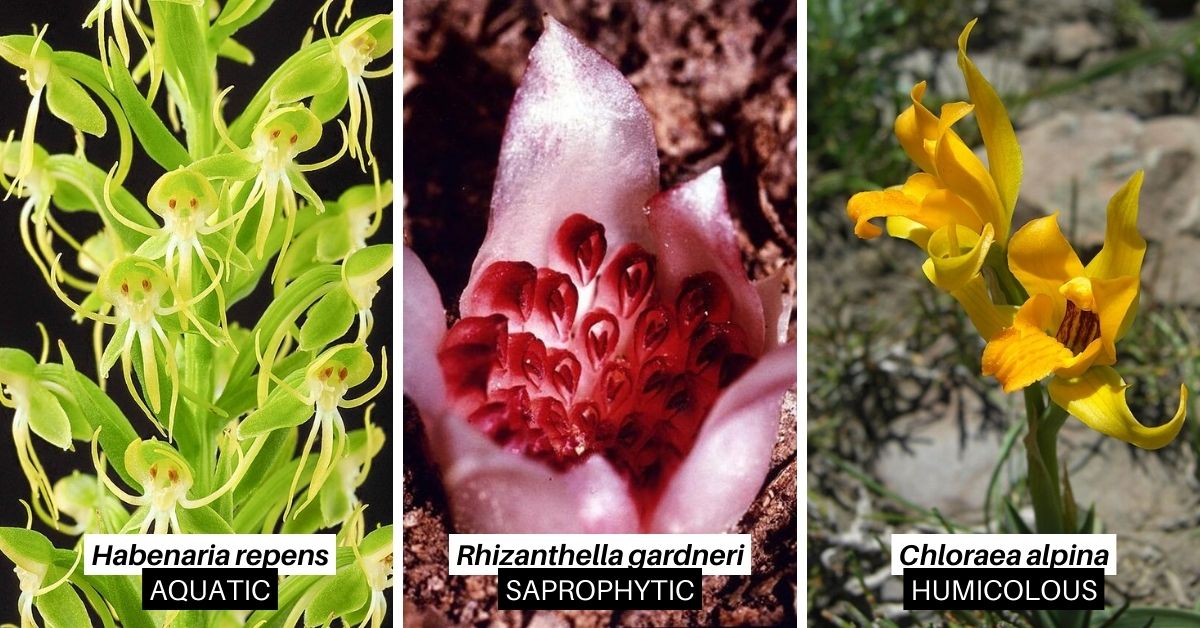
Keep in mind that orchids can exhibit more than one growth behavior on different substrates. In other words, a species can be rupicolous or epiphytic successfully, depending on the environment. Similarly, the behavior can be mixed, with the same orchid being terrestrial and climbing at the same time.
How Orchids are Grouped by Climate
If you have many orchids, a good idea is to use classification by climate. This way, you can group different types of orchids so that you can treat them similarly, making management easier. Also, organizing orchids by climate type is smart when thinking about placing them in the garden. Choosing plants that are suitable for your region’s climate will increase your chances of success with these demanding plants.
Here in Curitiba, for example, you can plant Cymbidiums directly in garden beds because they love the cold weather here and bloom abundantly.
So, orchids can be divided into three types based on the temperatures they thrive in – cool, temperate, and warm.
1. Cool Climate Orchids:
In this group, you’ll find orchids that appreciate cooler weather, with milder temperatures, without experiencing extreme cold, frost, or snow. They are usually native to temperate, subtropical, or high-altitude tropical regions, such as the Himalayas or the Andes, and are suitable for cultivation in this type of climate. In the summer, they prefer temperatures between 16°C and 21°C (60°F-70°F), and in winter, it’s best if the temperature doesn’t drop below 10°C (50°F).
Cool-growing orchids include Cymbidium, Dendrobium, Odontoglossum, and Miltoniopsis. Often, trying to cultivate these species in warmer locations is possible, but they may lack the cold and necessary photoperiod to bloom.
2. Temperate Climate Orchids:
This type of orchid prefers temperatures that are comfortable for humans. That is, not too hot, not too cold. They thrive in temperatures between 18°C and 24°C (65°F-75°F), generally. In winter, no frost or intense cold. It’s ideal that temperatures don’t drop below 15°C.
Orchids that prefer a temperate climate include Cattleya, Paphiopedilum, and Oncidium. These orchids are ideal for cultivation in Atlantic Rainforest regions.
3. Warm Climate Orchids:
If the environment is warm and humid, like an equatorial forest, then these orchids will thrive. While we are sweating and dealing with mosquitoes, they are happy with temperatures between 20°C and 30°C (65°F-85°F). The beautiful Vanda and Phalaenopsis love this type of climate. That’s why it can be challenging to cultivate them in some locations.
If you live in a cooler or drier area, remember to adapt the environment for them. Create a humid greenhouse, use humidifiers, and avoid cold air conditioning.
The Botanical Subfamilies of Orchids
If you’re looking for a more technical classification of orchid types, know that they are botanically classified into subfamilies. After all, with such a large plant family, it’s easy to get lost. By separating them into subfamilies, we can better understand the relationships between different species and their characteristics, which is very helpful when learning to identify these plants.
1. Apostasioideae: The Primitive Orchids
Apostasioideae is the most primitive subfamily of orchids. These orchids are known for their ancestral characteristics and are considered the closest to the original orchids. They usually have small flowers that are not as showy as other subfamilies but still have a unique appeal.
These orchids lack the labellum, that special modified petal, and pollinia for gathering pollen grains. Additionally, they are terrestrial, have no rhizome, and are erect, reaching up to one meter in height.
Orchids of this type do not naturally occur in Brazil. They are native to Southeast Asia and nearby islands such as Ceylon, Japan, and northern Australia, where they are found in shaded and humid environments of tropical forests.
2. Vanilloideae: The Vanilla Orchids
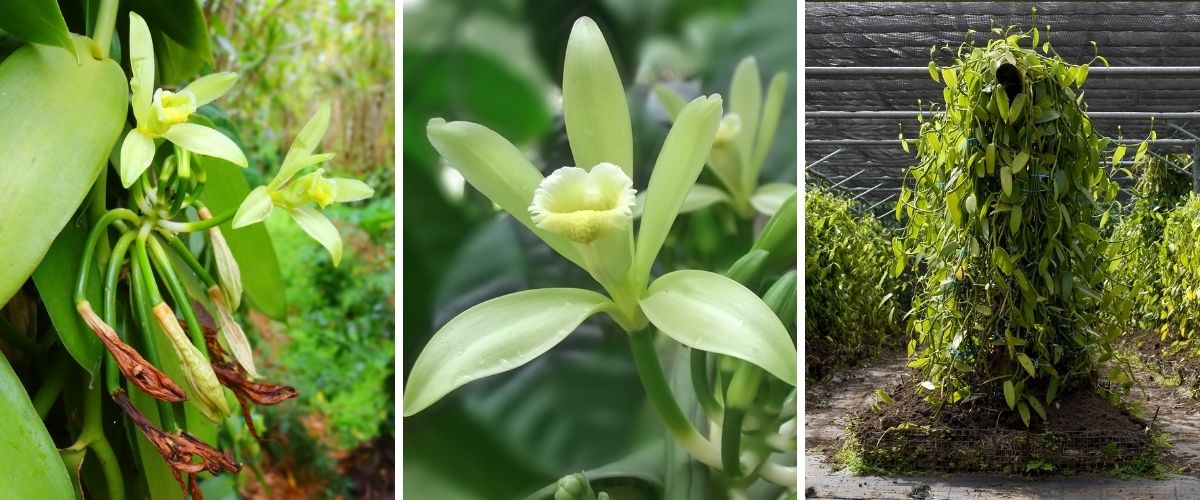
Climbing Vanilla
Vanilloideae is a subfamily that includes some of the most well-known orchids, such as the vanilla orchid (Vanilla planifolia). These orchids are famous for their use in vanilla production and have showy and aromatic flowers. They are widely cultivated in many parts of the world due to their commercial value.
Orchids of the Vanilloideae subfamily can be terrestrial or climbing. Some of them lack chlorophyll. They can have fleshy, tuberous roots like potatoes or even aerial roots to help them climb. They may also have fleshy leaves, although in some cases, the leaves may be absent or modified. Their flowers are usually beautiful, with separate petals and sepals. With the exception of some genera, these orchids do not have pollen grouped into real pollinia.
These orchids are found on all continents, and many species can be found in Brazil.
3. Cypripedioideae: The Slipper Orchids
Cypripedioideae, also known as the slipper orchids subfamily, is characterized by their peculiar flowers, with a labellum resembling a little
bag or a small shoe. These orchids are loved for their unique shape and vibrant colors. They are popular among orchid collectors due to their distinctiveness.
You can find them in tropical to temperate areas worldwide, except in Africa and Australia. Well-known representatives are orchids from the genus Paphiopedilum, Phragmipedium, and Cypripedium.
4. Orchidoideae: The Discreet Orchids
Orchidoideae is a diverse and numerous subfamily of orchids. They are known for their versatility and adaptability to different climates and environments, but mainly because they don’t always look like orchids and are often mistaken for common weeds.
These orchids can vary in size and shape, but they usually have small, numerous flowers in soft colors. Although laypeople may have difficulty recognizing them, collectors find these orchids fascinating and delicate. The best-known representative of this type of orchid is Ludisia, also known as the Jewel Orchid.
5. Epidendroideae: The Largest Subfamily of Orchids
Epidendroideae is the largest subfamily of orchids and covers a wide range of species, including the most well-known commercial species. They are known for their stunning flowers and their ability to grow in a variety of habitats, from tropical forests to high mountain regions.
This subfamily includes some of the most spectacular orchids in the world, such as the Cattleyas, Vandas, Dendrophals, Ascocendas, and Phalaenopsis, etc.
Now that we’ve explored the five main subfamilies of orchids, it’s evident that these plants are truly extraordinary in their diversity and beauty. Each subfamily has its own unique characteristics, making them special in their own way.
Orchids are a fascinating group of plants worth studying and appreciating. Their subfamilies offer a detailed insight into how these plants have evolved and adapted over time. It’s definitely worth getting to know these major groups.
The 23 Most Common Types of Orchids in Our Gardens and Homes
And of course, we couldn’t miss the most popular orchid species among orchid enthusiasts in this article. Whether you are a collector or not, you will certainly come across these beautiful species when visiting the florist or garden center near your home. Let’s learn a little about each of these types of orchids and how to better care for these botanical beauties:
1. Bamboo Orchid – Arundina graminifolia
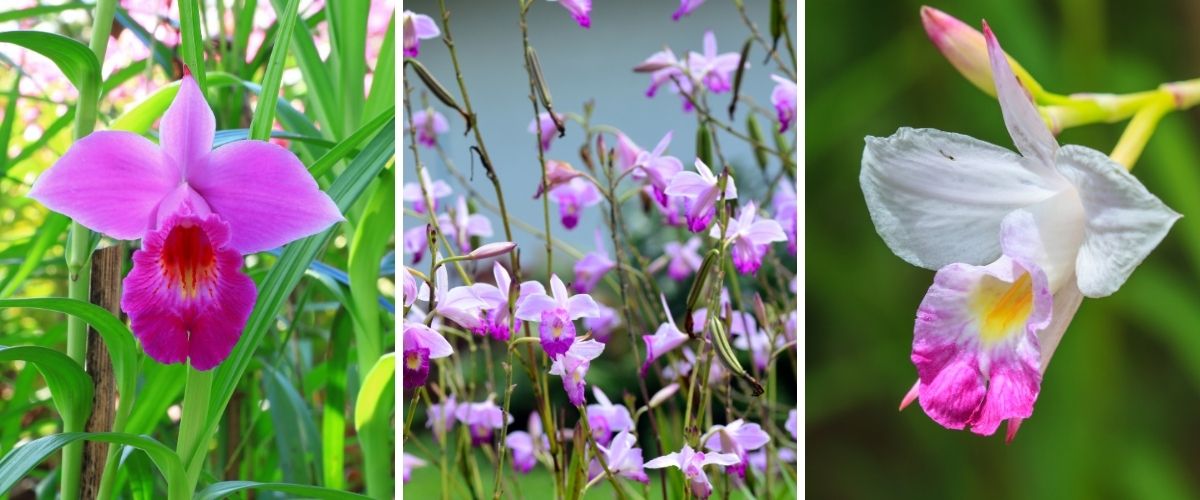
Did you know that the bamboo orchid, also known as Arundina gramminifolia, is native to tropical regions of East and Southeast Asia? These orchids are terrestrial and have tall stems, similar to bamboo, with delicate flowers at the top in shades of pink or white. They bloom during the summer months (sometimes year-round in tropical climates) and can reach impressive heights. If you’re looking for a striking orchid for your garden, Arundina is an excellent choice.
2. Spider Orchid – Brassia rex
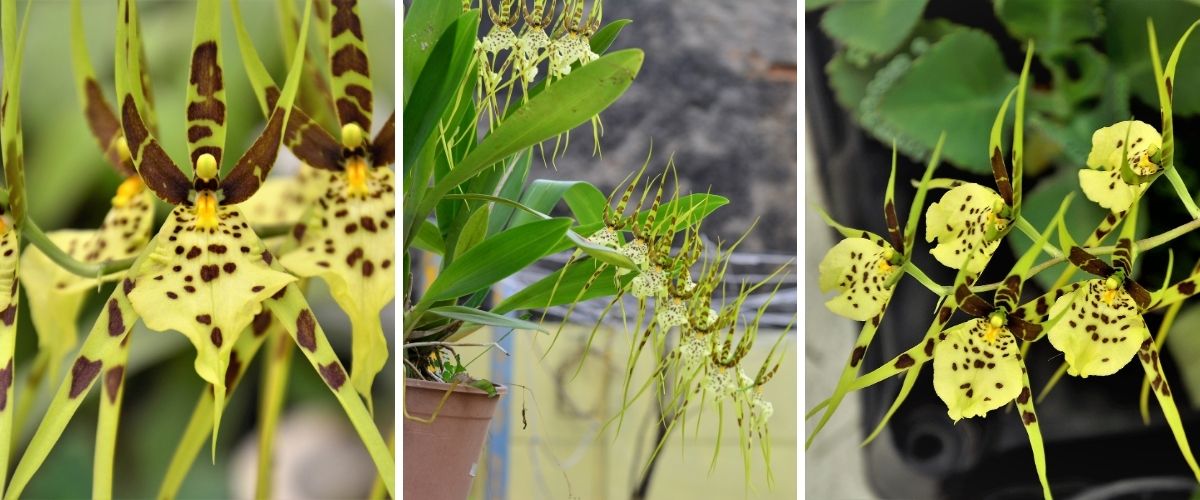
The spider orchid, or Brassia rex, is famous for its exotic flowers that resemble spiders. With long petals and sepals that extend like hairy legs, this orchid is a true marvel of nature. The flowers come in clear, white, yellow, or green with often spots. Brassia rex is a sympodial and unique orchid that will surely stand out in your collection. They thrive in well-ventilated environments with high humidity and indirect sunlight.[/caption]
3. Bulbophyllum rothschildianum
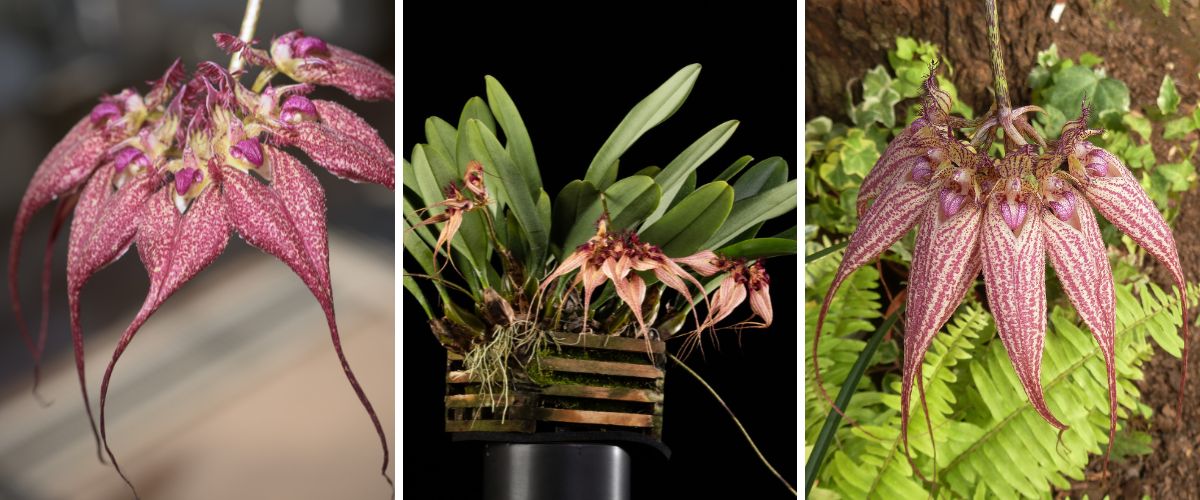
If you’re looking for a rare and stunning orchid, Bulbophyllum rothschildianum is an exceptional choice. Native to China, Burma, and India, this orchid is known for its impressive flowers that resemble pointed balloons, clustered in umbels, forming umbrella-like structures. Additionally, its flowers emit a peculiar aroma that attracts pollinators. Having a Bulbophyllum rothschildianum in your orchid collection is a true botanical experience.
4. Queen of Orchids – Cattleya labiata
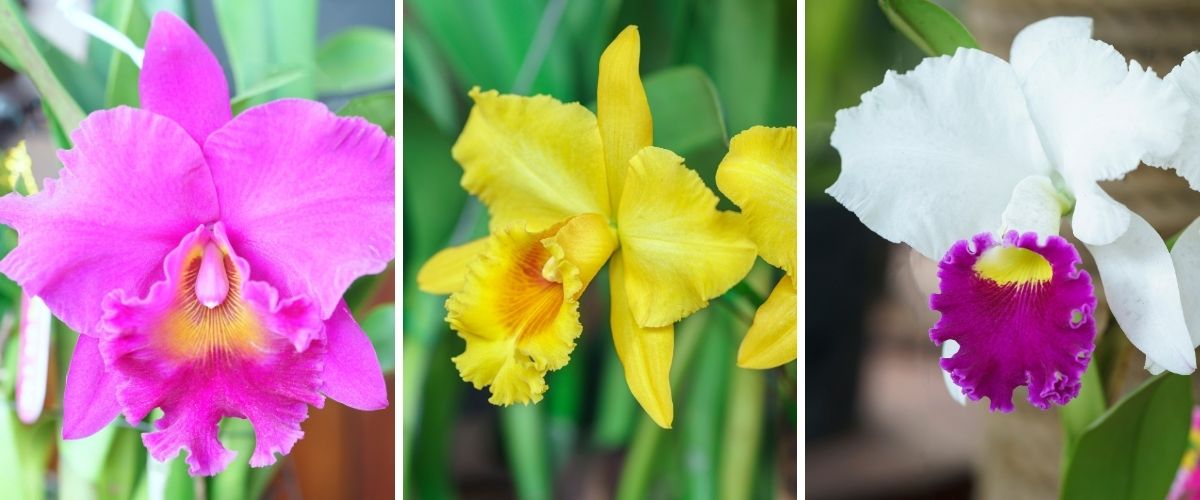
One of Brazil’s most iconic orchids. This species is known for its large and showy flowers, and for its contribution to the formation of numerous hybrids in various colors, including shades of pink, purple, and even red. Cattleya labiata is native to Brazilian regions and is considered a national symbol, often associated with elegance and beauty. Its flowers emit a subtle and captivating fragrance, making it even more enchanting for orchid lovers.
5. Snow White Orchid – Coelogyne cristata
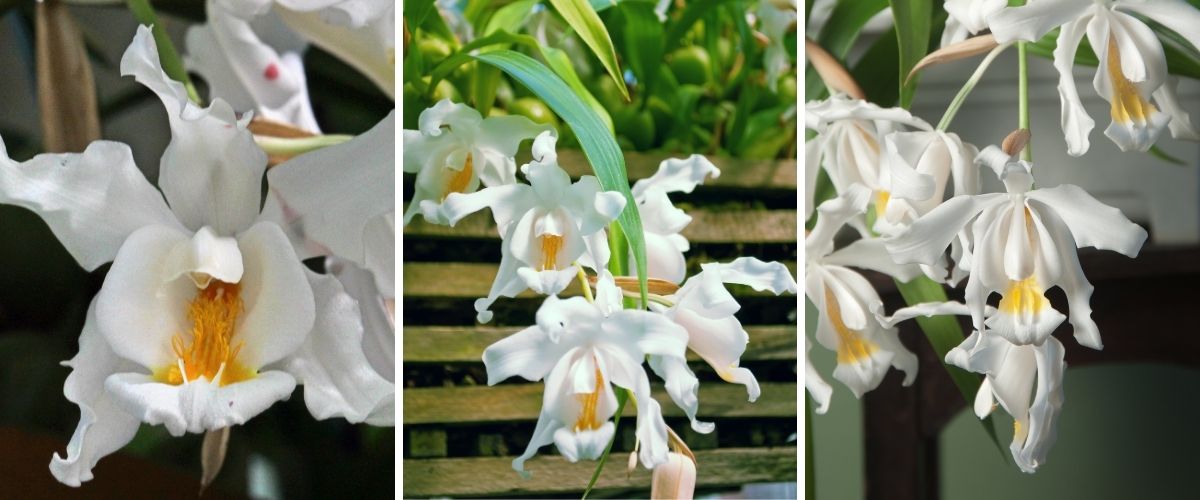
Coelogyne cristata is an orchid that stands out for the uniqueness of its flowers. Originating from the Himalayas and Southeast Asia, this orchid has white and delicate flowers. They are fringed with a golden yellow center, creating a stunning contrast with the lush green leaves. Moreover, this orchid is resilient and easy to care for, making it suitable for gardeners of all experience levels and one of the most cultivated orchids worldwide.
6. Cymbidium Orchid – Cymbidium sp
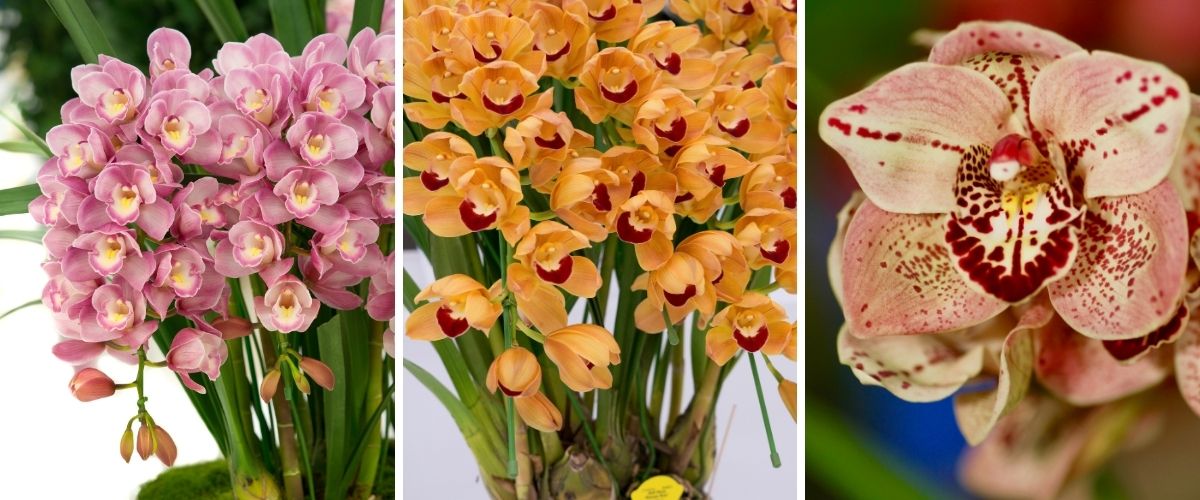
Orchids of the genus Cymbidium are known for their large and elegant flowers. They come in a variety of colors, including white, pink, yellow, and green. Like Coelogyne cristata, they originate from the Himalayan region in Asia. Cymbidium orchids are appreciated not only for their beauty but also for their long-lasting cut flowers. If you want to create stunning floral arrangements, Cymbidium orchids are an ideal choice. Grow them in a rocky to sandy substrate, preferably in subtropical to temperate climates, as they appreciate the cold.
7. Cooktown Dendrobium – Dendrobium bigibbum
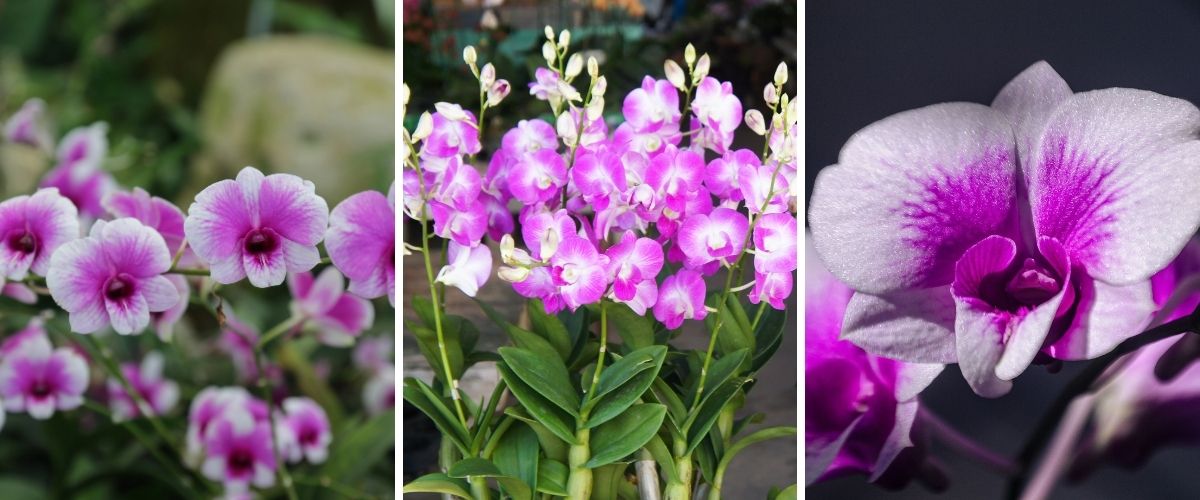
Finally, we can’t forget to mention Cooktown Dendrobium orchids. These orchids are known for their small but abundant flowers that resemble butterflies. They come in a variety of vibrant colors and are native to Australia and New Guinea. Denfalen orchids are perfect for those looking for an easy-to-care-for, elegant, and delicate orchid.
8. Noble Dendrobium – Dendrobium nobile
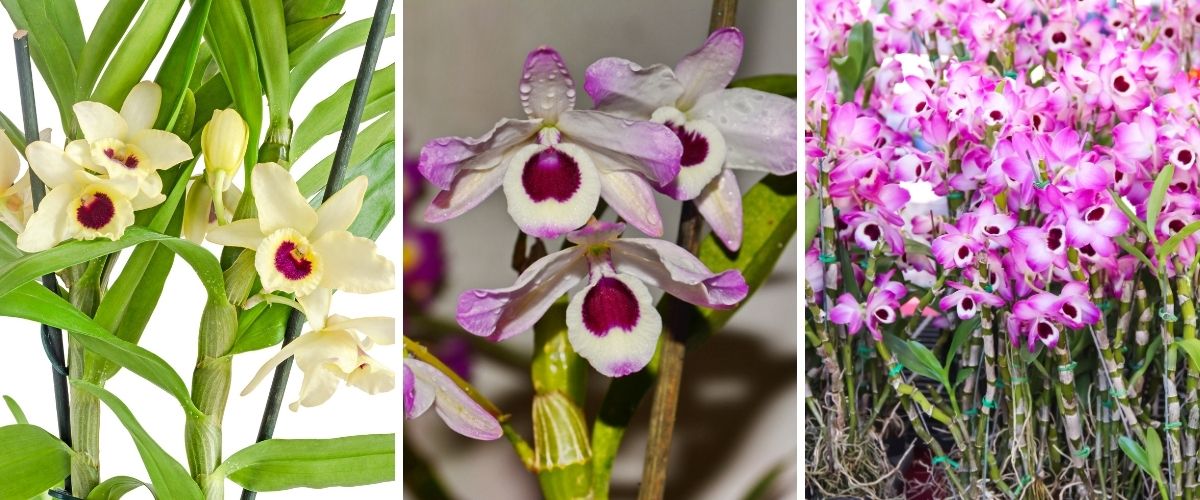
The Dendrobium nobile, known as the “Noble Dendrobium”, is one of the most popular orchids! But few people know that it is native to Southeast Asia. Its delicate flowers are a spectacle for the eyes, with petals in soft shades of pink and white. A notable feature of this orchid is its ability to bloom even during the winter, brightening our homes when we need beauty and color the most. In addition to looking perfect in pots with the right substrate for epiphytes, it can be attached to backyard trees and adapts to different light conditions.
9. Beach Orchid – Epidendrum fulgens
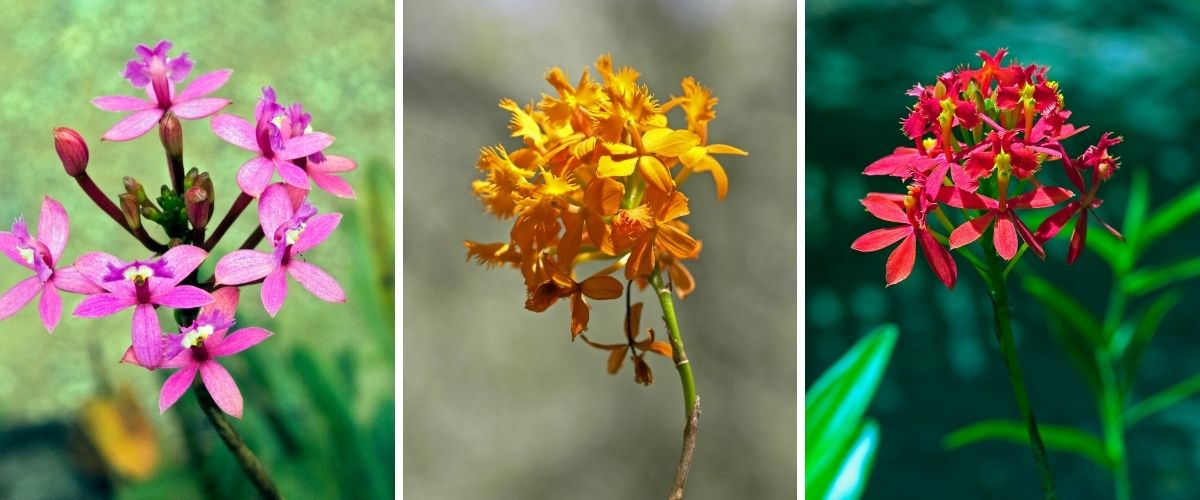
The Epidendrum fulgens, affectionately called the “Beach Orchid,” is native to Central and South America. Its vibrant flowers in shades of red, yellow, and orange resemble a tropical beach sunset. This orchid is resilient and easy to cultivate, making it a popular choice for gardeners of all experience levels. Keep in mind that it is terrestrial and prefers sandy soil, making it suitable for coastal regions as it tolerates salinity.
10. Laelia purpurata
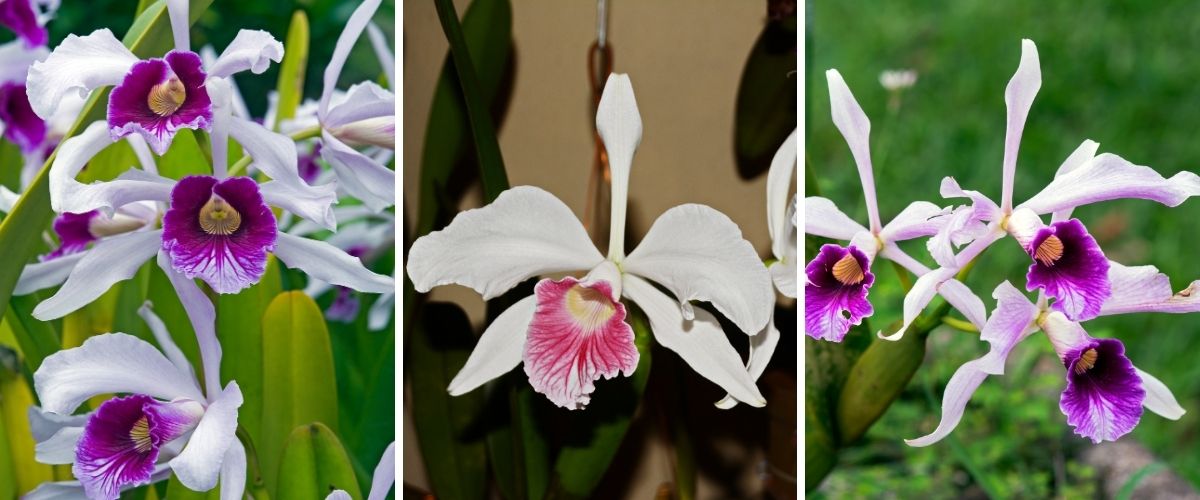
Laelia purpurata is one of Brazil’s most majestic and iconic orchids. Its large and lush flowers come in a variety of colors, including purple, pink, red, and white. This orchid is a true national treasure and is widely appreciated for its beauty and elegance. Grow it in filtered light, in a substrate suitable for epiphytes, rich in pine bark, charcoal, coconut chips, gravel, and sphagnum moss.
11. Jewel Orchid – Ludisia discolor
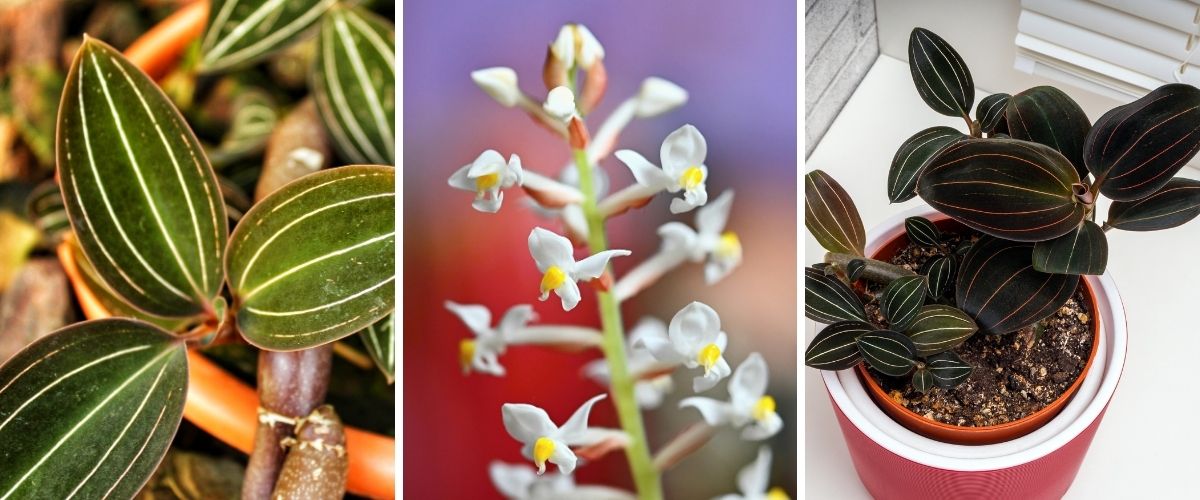
Ludisia discolor, known as the “Jewel Orchid,” is a terrestrial orchid native to Southeast Asia. What makes it special are its lush leaves with intriguing patterns resembling precious jewels, making it suitable for ground cover. Although its flowers are small and discreet, its leaves make it a standout plant in any collection. It’s perfect for terrariums, adding the necessary contrast with green plants.
12. Coconut Orchid – Maxillaria tenuifolia
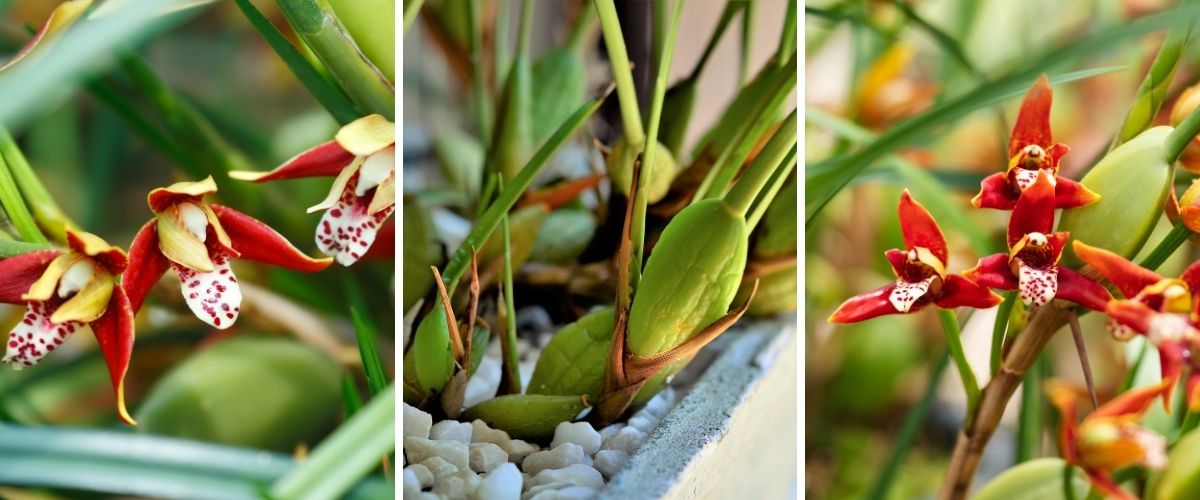
Maxillaria tenuifolia, nicknamed the “Coconut Orchid,” is an epiphytic orchid with a truly unique aroma. Its flowers have a fragrance reminiscent of coconuts, creating a unique sensory experience. Originating from high-altitude regions in Central America and southern North America, this orchid is an interesting choice for those who appreciate tropical scents.
13. Pansy Orchid – Miltoniopsis
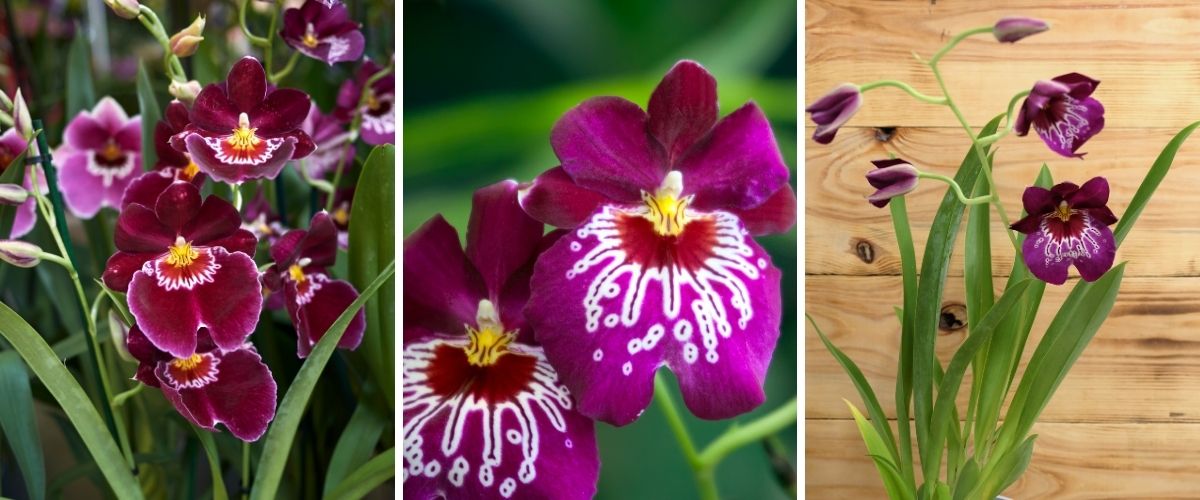
Miltoniopsis, affectionately called the “Pansy Orchid,” is a charming orchid with large flowers that resemble pansies. It is native to Central America and has a reputation for not being very easy to cultivate. Its secrets: They like frequent, non-soggy watering and appreciate filtered light. Be attentive, as they exhibit a subtle pinkish hue on their leaves when exposed to the right amount of light.
14. Golden Shower – Oncidium sp
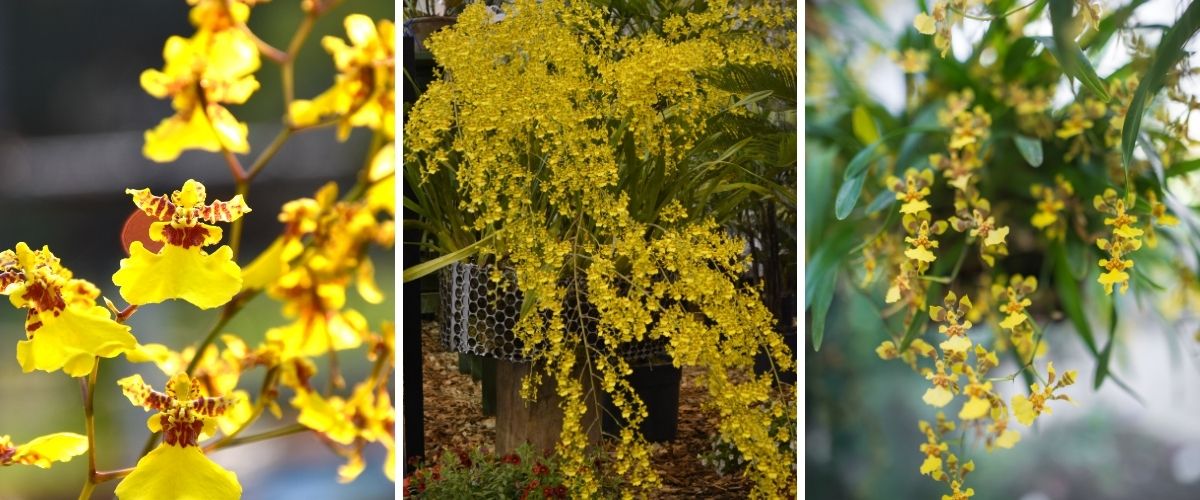
The Oncidium, known as “Golden Shower,” is an orchid famous for its yellow flowers that resemble golden rain. It is native to South America and is a popular choice for gardens and floral arrangements due to its unique and long-lasting beauty. It thrives under intense light, and in nature, it prefers the tips of tree branches to attach itself.
15. Chocolate Orchid (Oncidium ‘Sharry Baby’)
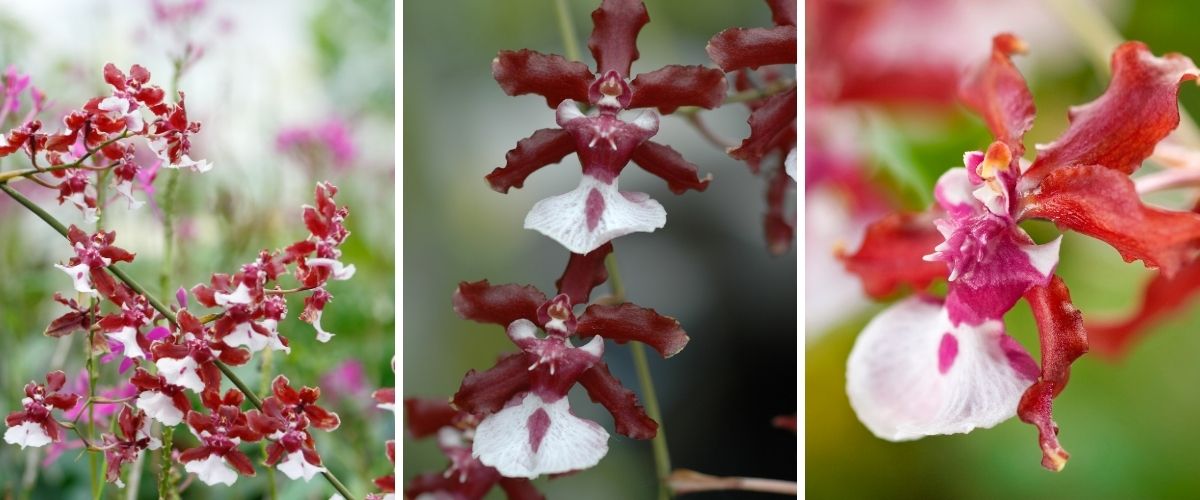
This fascinating cultivar of Oncidium is notable for its inflorescences that emit a chocolate-like aroma, hence the popular name. The flowers of Oncidium Sharry Baby are usually dark brown with contrasting spots and feature a distinct structure with petals and sepals that resemble little dancers. It requires growing conditions similar to other Oncidium orchids.
16. Lady’s Slipper Orchid – Paphiopedilum sp
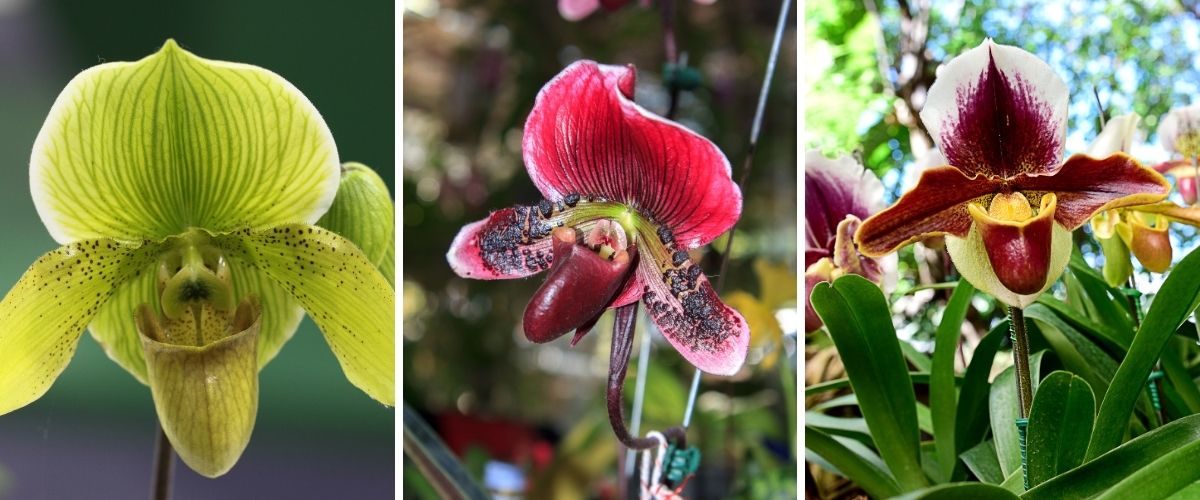
The Lady’s Slipper Orchid, also known as Paphiopedilum, is a unique orchid that stands out due to the shape of its flowers, with inflated labellums resembling exotic slippers. It is native to tropical and subtropical regions of Asia and comes in a variety of colors and patterns. Paphiopedilum is appreciated for its elegance and makes an impressive addition to any orchid collection.
17. Nun’s Hood Orchid – Phaius tankervilleae
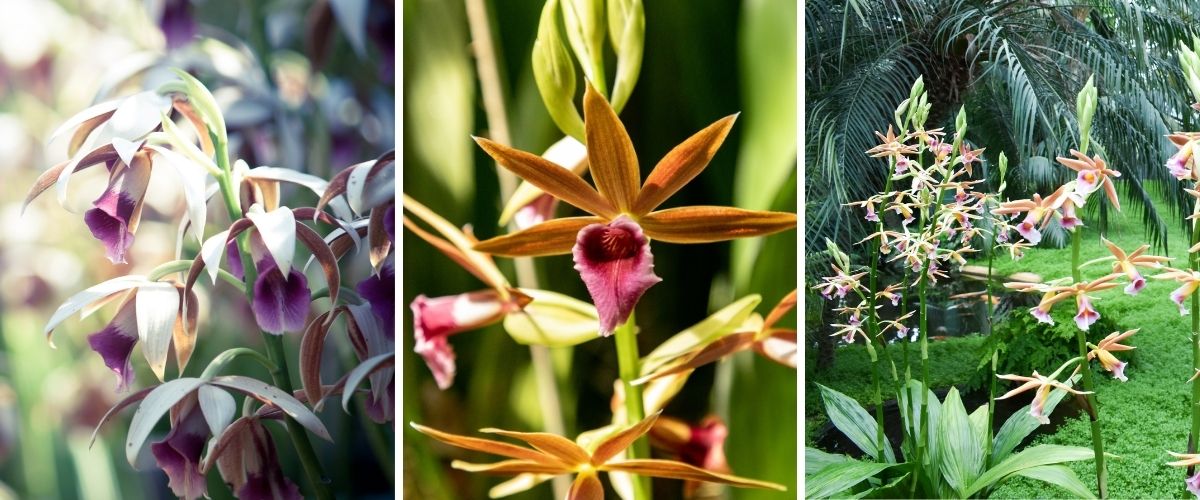
The Nun’s Hood Orchid (Phaius tankervilleae) is a robust and resilient plant known for its tall and majestic inflorescences. Its flowers have a shape reminiscent of a nun’s hood, hence the name. They can vary in shades from white to pink and even darker tones. Terrestrial and easy to cultivate, this orchid is an excellent choice for gardeners seeking a low-maintenance plant with stunning flowers.
18. Butterfly Orchid – Phalaenopsis sp
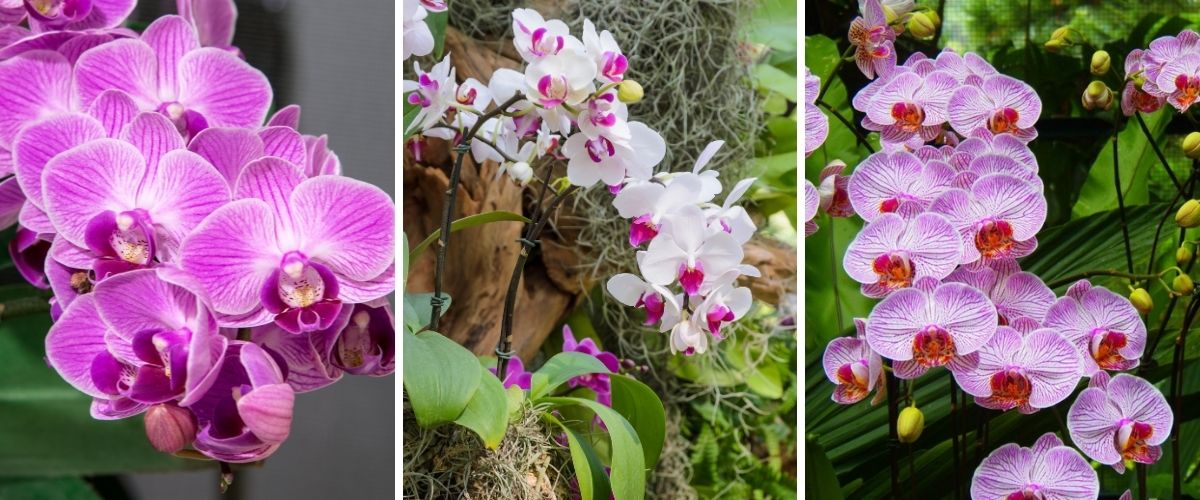
The Butterfly Orchid is one of the most popular and widely cultivated orchids worldwide. Its delicate and long-lasting flowers bear a remarkable resemblance to flying butterflies. They are available in a wide range of colors, from pure white to shades of pink, yellow, and even blue (artificially colored, of course!). The Phalaenopsis is quite resilient and perfect for beginners, making a charming addition to any indoor environment.
19. Bridal Veil Orchid – Rodriguezia venusta
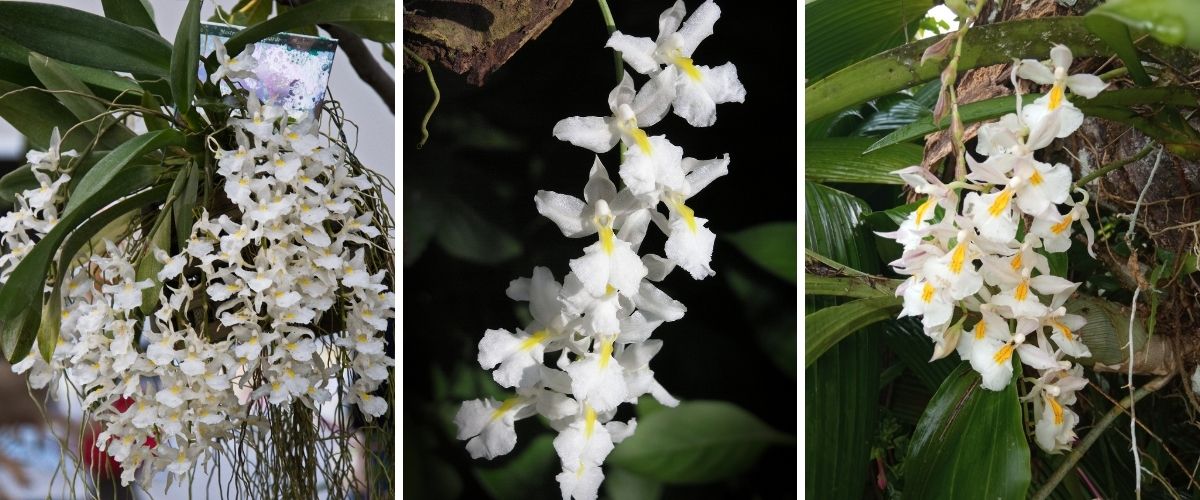
The Rodriguezia venusta, known as the Bridal Veil Orchid, is a medium-sized orchid with small and charming flowers. It is native to South America and is appreciated for its fringed flowers in dense clusters and its mild, sweet fragrance. Bridal Veil Orchid is a lovely choice for those wanting a graceful orchid in their garden. It prefers being in trees and dislikes pots. As it doesn’t like pots, alternatively, we can plant it in wooden cage-like cachepots.
20. Grape Orchid – Spathoglottis unguiculata
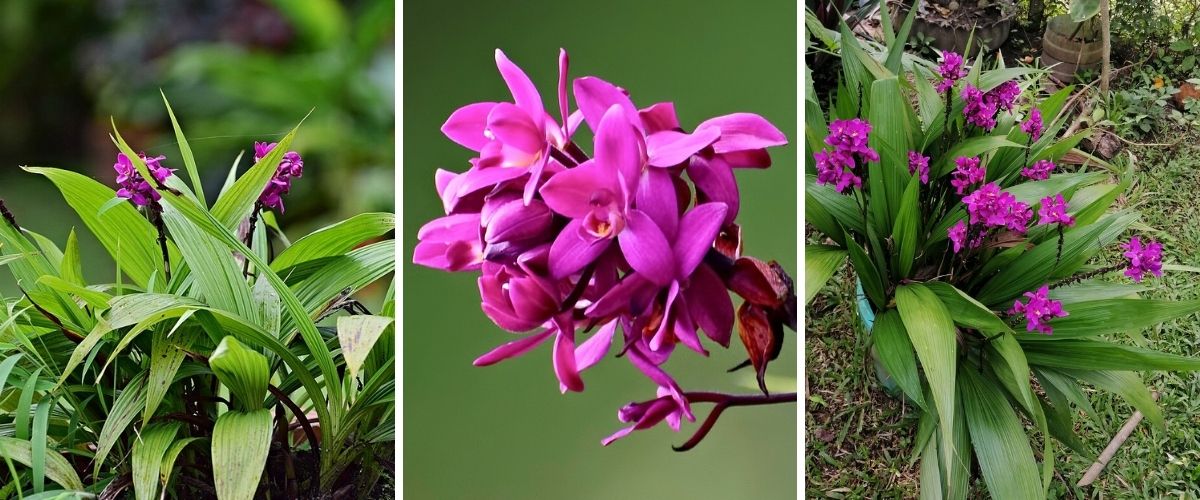
The Grape Orchid, or Spathoglottis unguiculata, is a terrestrial orchid known for its purple and lavender-toned flowers. It is renowned for its resilience and ease of cultivation, as well as the characteristic grape soda scent of its flowers. This orchid is an excellent choice for novice gardeners wanting to try terrestrial orchid cultivation. Additionally, its pleated leaves add beauty to flower beds even when the plants are not in bloom.
21. Sobralia – Sobralia macrantha
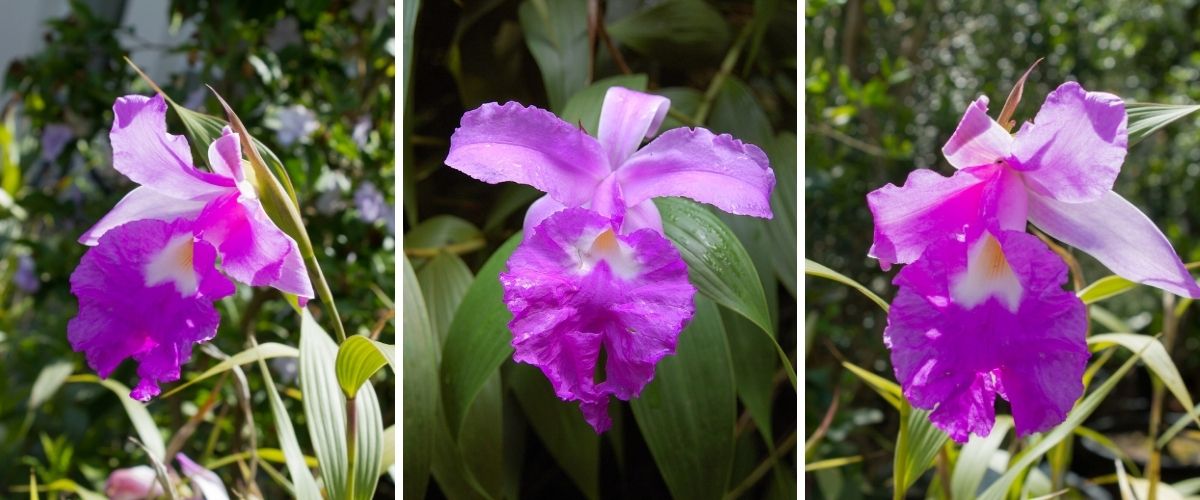
The Sobralia, or Bamboo Orchid, is a terrestrial orchid native to Central and South America. A notable feature of Sobralia is its growth habit, with upright stems and lanceolate leaves. Its flowers are equally impressive, large with lilac-colored petals and sepals, and a large labellum that can vary in color, usually displaying shades of pink, yellow, or orange. It requires indirect to moderate light and should be regularly watered to keep the substrate slightly moist.
22. Vanda – Vanda sp
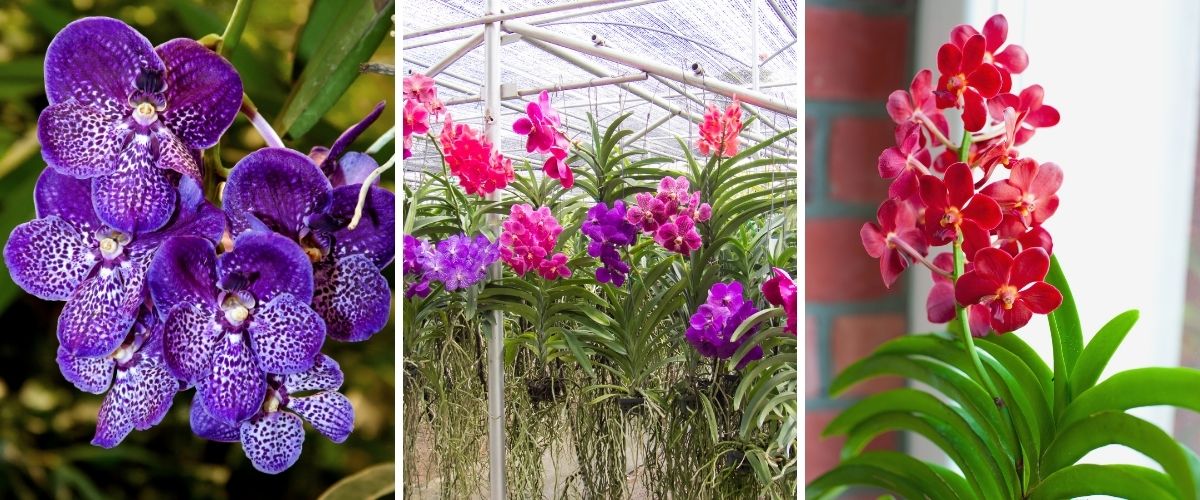
The genus Vanda includes large and majestic orchids known for their vibrant and long-lasting flowers that emerge on upright monopodial growth stems. Vanda orchids come in an impressive array of colors, including blue, purple, pink, and orange. These orchids are ideal for those seeking a touch of tropical elegance in their garden. However, please note that they thrive in high humidity and may struggle in dry climates.
23. Zygopetalum maculatum
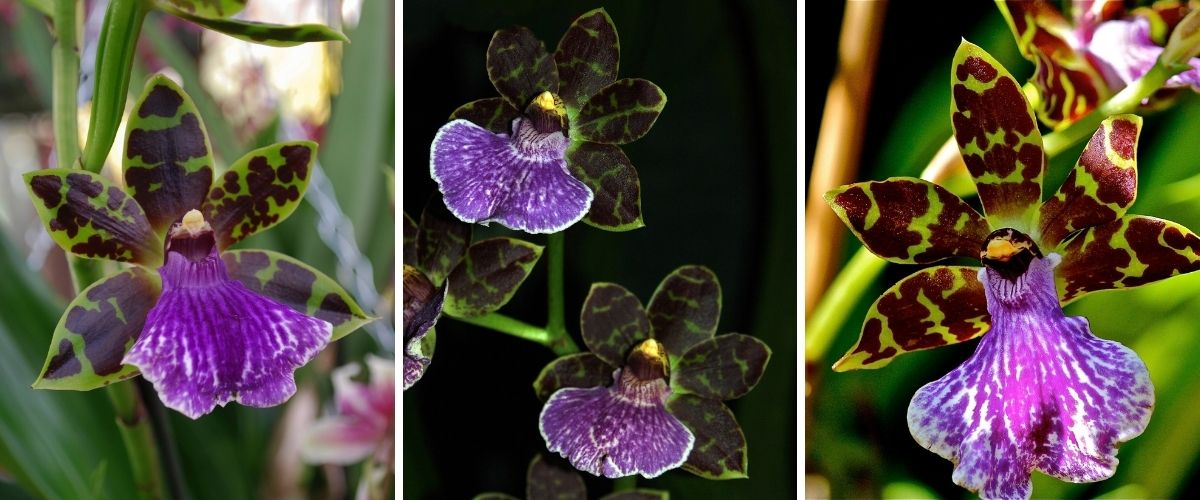
The Zygopetalum maculatum is a fascinating orchid with star-shaped flowers that emit a unique and pleasant fragrance. It is native to South America and is known for its green petals and sepals with brown-red spots and a white labellum marked with violet streaks. Cultivating Zygopetalum maculatum is a truly captivating experience for any orchid enthusiast.
The different types of orchids are amazing! Each one is more beautiful than the other.
And now?
We discover in this guide that orchids are fascinating and diverse flowers, with a wealth of species that enchant gardening enthusiasts all over the world. From the spectacular Brazilian Cattleyas to the elegant Phalaenopsis cultivated in our homes, the various types of orchids hold a special place in our hearts and gardens.
If you were amazed by the diversity of orchid types that our planet has to offer, don’t hesitate to share this article with that friend of yours who loves flowers and gardens. Share the beauty and knowledge about these extraordinary flowers on your social networks and inspire others to appreciate and care for these botanical gems.
Together, we can spread the passion for orchids and contribute to the conservation of these incredible plants. Thank nature for its beauty and fragility, and remember that preservation begins with awareness. Share this article now and be part of this movement!

